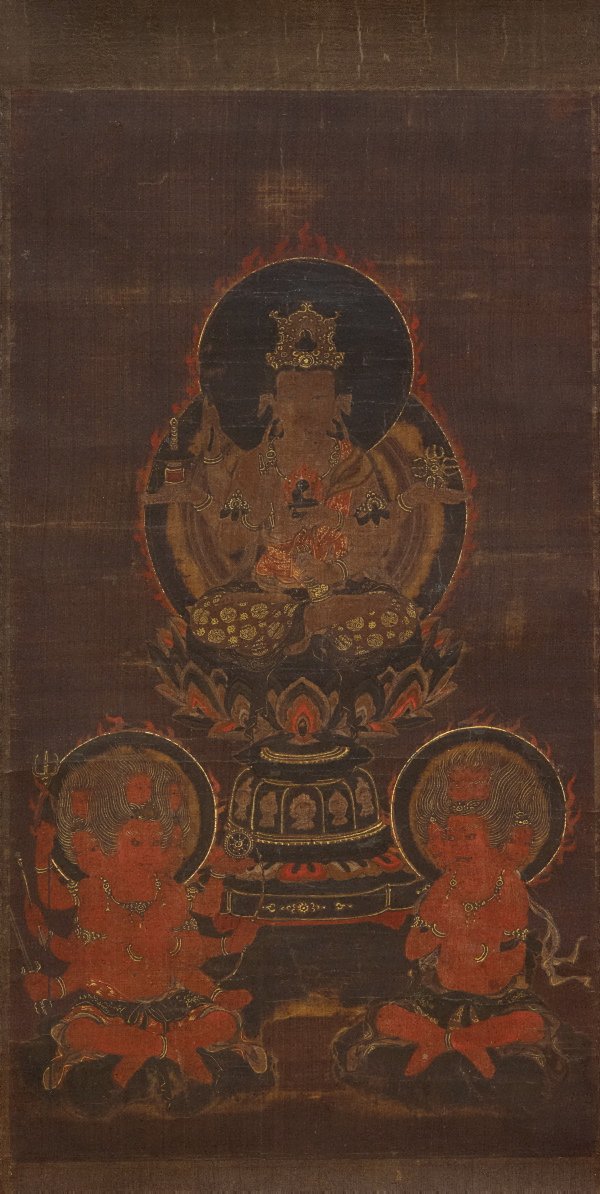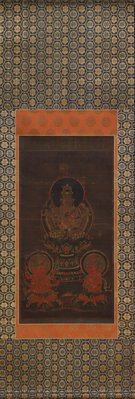-
Details
- Place where the work was made
-
Japan
- Period
- Nanbokucho period 1336 - 1392 → Japan
- Date
- late 14th century
- Media categories
- Scroll , Painting
- Materials used
- hanging scroll; ink, colour and gold on silk
- Dimensions
- 57.0 x 31.5 cm image; 137.8 x 47.0 cm scroll
- Credit
- Purchased with funds provided by the Asian Art Collection Benefactors 2012
- Location
- Not on display
- Accession number
- 138.2012
- Copyright
- Share
-
-
About
Even though the term ‘Sanbō’ in this deity’s name refers to the ‘Three Treasures’ of Buddhism (i.e. Buddha, Buddha’s law and the community of believers), he is not mentioned in any authentic Buddhist texts. His origin is obscure, but in Japan, Sanbō Kōjin is worshipped by the Shūgendō order as the Buddhist manifestation of a Shintō deity. Founded by the ascetic and mystic En-no-Gyōja (b. 634), Shūgendō is a syncretic religion that combines aspect of Taoism, esoteric Buddhism, Shintō as well as ancient Japanese shamanism. Kōjin is widely revered as the deity of the home, especially the kitchen, but also as the protector of cattle and horses. Representations of Kōjin, both in sculpture and painting, are extremely rare before the 15th century. They can show him in one of his three forms: as Sanbō Kōjin – the most common form – with angry features, eight heads and six or eight arms holding various weapons; as Nyōrai Kōjin with a benevolent face identical to Kongōsatta (sanskr. Vajrasatta, the deity of purification) but with six arms; as Kojima Kōjin, who appears with four arms holding a jewel and a 'cakra' (an ancient Indian wheel-symbol for royalty) and is dressed in court attire.
The central figure in this hanging scroll shows Sanbō Kōjin in his Nyōrai form sitting on a lotus pedestal. Flaming halos encircle his head and body. His three right arms hold a lotus bud, a stupa and a 'vajra', while his three left arms carry a double six-pronged 'vajra', the wish-granting jewel and a bell with a 'vajra'-handle. The identification of the two accompanying figures sitting on a rock pedestal below him, on the other hand, poses some difficulty as they seem to conflate various divinities of the Buddhist pantheon. The figure to the lower left (seen from the viewer) has six faces and six arms holding the wheel, bow and rope on the right and spear, bow and sword on left. The figure on the lower right (seen from the viewer) has three faces (and a crown with further six faces) and two hands forming the ‘Six Element mudra’ usually associated with Dainichi Nyōrai. The wrathful faces and multiple arms are characteristics for the Five Great Wisdom Kings ('Godai Myōō'), however, the attributes they carry do not match with the orthodox iconography of the 'Myōō'.
The temple Taisanji in Hyogo Prefecture has an almost identical painting. The two accompanying figures are identified there as Sanbō Kōjin (eight faces, eight arms) and Hachidai Kōjin, an extremely rare form of Kōjin with three faces and two arms forming the ‘Six Element mudra’. While the figure to the lower right is thus identical in both paintings, the iconography of the figures on the left is slightly different.
The Taisanji-scroll is dated to the late Nanbokuchō period (1336-92), leading thus to the assumption that the scroll proposed here is from the same time. Even though darkened due to the long exposure in temple decoration, this painting still reveals excellent brushwork and great attention for details in the depiction of the golden patterns on the robes and the various attributes.
Asian Art Department, AGNSW, June 2012.
-
Places
Where the work was made
Japan
-
Provenance
HG Seiler collection, pre 1980s, Erlangen/Germany
Helmut Brinker, 1980s-2012, Switzerland, purchased by the Art Gallery of New South Wales, Sydney, June 2012.

